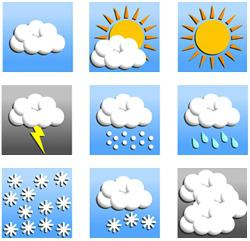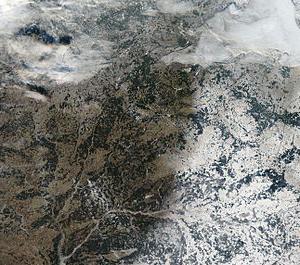Climate Belarus has its own characteristics, which are due to the geographical position of the country. Climate and weather conditions are of considerable importance, therefore much attention is paid to this.
Information on the history of observations of climate change in Belarus
To be interested in the question of what climate in Belarus began in the 9-10th centuries. The oldest data on the climatic conditions of Belarus are found in the annals and notes of travelers. The first meteorological station was opened in Mogilev in 1809, then in Vitebsk (1810), Brest (1834), Gorki (1841), Minsk (1849) However, only after the October Revolution did a deeper study begin climate. 1930 was notable for the fact that various weather services began to function at that time, and methods for forecasting frosts appeared.
The first to describe in detail the climate of Belarus, which is still reliable information, was A. I. Kaygorodov. At this time, there was complete information on the climatic conditions of large cities, and the country's agroclimatic zoning was carried out. Since that time, information from automatic meteorological stations and satellites has been used in weather forecasts and mapping. This information is very important for scheduling agricultural work.
The main characteristic of the climate of Belarus
The climate of Belarus is temperate continental with Atlantic cyclones. As for winter, it is moderately cold, characterized by prolonged thaws. If we consider the summer, we can say that it is moderately warm. The average annual rainfall is from 550 mm in the south of the country to 750 mm in the hills.
The climate of the Republic of Belarus and its features are determined by the geographical position of Belarus in the zone of temperate latitudes, where the plain topography prevails, there are no orographic barriers, and also a great distance from the Atlantic Ocean.
The angle of incidence of the sun's rays and the duration of the day and sunshine are determined by the latitudinal location of the territory of the republic in the zone of 56 ° and 51 ° north latitude. The amount of penetrating solar radiation also depends on this. For a year, the amount of solar radiation varies from 3400 to 4050 MJ / m 2 .
The change of air masses over a country depends on the circulation of the atmosphere. The prevalence of moist air masses is caused by the predominance of western transport in the lower atmosphere. In the eastern regions, ocean influence is declining, and climate continentality is increasing.
Due to the dominance of western transport, western cyclones occur that bring humid air. Thaws, precipitation and slight warming appear in the cold season, and in summer the weather becomes cool, rains come. Cyclones from the northwest appear much less frequently.
The thermal regime is characterized by positive air temperatures on average per year, which rise south and southwest. The average temperature in the north is 4.4 ° , in the south-west - 7.4 ° . In January, in the south-west the temperature averages -4.1 ° , and in the north-east -8.4 ° . July average temperature ranges from +17 ° to +19.7 ° .

The Republic of Belarus is in the field of sufficient moisture. The average annual rainfall is due to the topography of the territory and has an indicator of 500-600 mm in the lowlands, and in the hills - 550-700 mm. Between April and October, 70% of precipitation falls. In general, 70-80% of precipitation comes in the form of rain, 9-16% in the form of snow, and the remaining amount is in the form of mixed precipitation. At the end of February and the beginning of March, the highest snow cover is observed, which is 15-40 cm. The increased air humidity is caused by a significant amount of precipitation and the fact that the air temperature is low. Relative humidity above 80%. May is characterized by a minimum relative humidity. Due to high humidity, cloudiness and fog are observed. 85% of the time in the autumn-winter period is dominated by cloudy, cloudy weather.
General atmospheric circulation affects the wind regime. Western transport dominates. In winter, winds blow mainly from the southwest. Winds in the summer blow from the northwest. The average wind speed per year is about 4 m / s in open areas, in the basins - about 3 m / s. Storms and tornadoes are sometimes noted.
Negative climate factors of the Republic of Belarus
The climate of Belarus has some negative factors. These include weather instability in spring and autumn, mild winters with thaws, rainy summers, insufficient moisture in early summers, and frosts. Various natural phenomena, such as tornadoes, dust storms, halo, directly depend on the characteristics of the ongoing atmospheric processes.
Weather and climate in Belarus at different times of the year
What is the climate in Belarus for each season? The location of the territory of Belarus in temperate latitudes led to a change in the seasons of the year. The duration of each season of the year is 3 months. But it should be noted that the beginning of the phenological pore in the republic usually does not correspond to the calendar dates. When comparing the north-eastern and south-western regions of the country, the most significant differences in these indicators are observed.
Climatic conditions in the spring
The phenological spring in Belarus begins in the 1st decade in the southwest. The northeast begins at the end of March with the transition t o of air through zero degrees upward. The spring season ends in late April and early May, when the temperature goes over +10 degrees Celsius upward.
The weather is characterized by instability, there is a frequent change of warm and cold air masses. The amount of precipitation is increasing, snow and ice are melting on the rivers, evaporation occurs, birds fly in, the process of plant vegetation starts, and agricultural work also begins. In spring, the number of sunny days increases. Air and earth gradually heat up.
Summer and its climatic features
Phenological summer begins in early May in the south and in mid-May in the north. The average daily temperature during the transition period is +12 with an increase in the indicator at the beginning of summer and, accordingly, the temperature gradually decreases at its end. The average temperature in July, in the warmest month of the season, is +17 ... + 20 ° C. In general, summers are warm in Belarus, and in some places there is heat. Precipitation in the summer falls in the form of rains, often prolonged. High temperatures with fairly low humidity, as well as storms and strong winds, are adverse weather events in the summer season.
Summer ends at the end of the 2nd - beginning of the 3rd decade of September in the north and east, at the end of the 3rd decade of September - the beginning of the 1st decade of October - in the south and southwest.
Autumn characteristic
The beginning of autumn is the date when the average daily air temperature goes over 10 ° C. The number of sunny days is decreasing by October. The appearance of snow indicates the end of autumn. There is a decrease in air and soil temperatures, it rains, the wind intensifies, but the total amount of precipitation decreases.
In early autumn, after a significant cooling, a sharp warming sets in, which is called "Indian summer." The weather is getting dry and clear. During this period, secondary flowering of some plants may occur.
Weather conditions in winter
What is the climate in the Republic of Belarus in winter? This is the coldest season of the year. Lowering the temperature below 0 is taken as the beginning of winter. At the end of winter, the temperature gradually exceeds this indicator.
Winter is characterized by cold air masses, prolonged drizzling rains, which are replaced by snow, unstable snow cover, ice, snowstorms. The weather in this season is mostly cloudy, fogs, hoarfrost, hoarfrost are formed, there is a frequent change of thawing and frosty periods.
Climate change in Belarus
Climate change in Belarus and its causes is a topic that has been studied very seriously lately. There are many reasons why the weather is changing. The climate features of Belarus during this period include changes in the parameters of the Earth’s orbit, the greenhouse effect, and anthropogenic causes, which are various types of human activity that entail environmental changes. The process of global warming is gaining momentum. Stopping it is already unrealistic. It affects agriculture, flora, fauna and human health itself. This is the climate of Belarus.

Over the past 100 years, there have been 3 periods of warming in the country, after which there was a sharp cooling. The first warming was at the end of the 20th - beginning of the 21st century. The next, the largest warming, was observed in the 30s. Third warming was noted in the 50-60s. The air temperature during the second warming exceeded the average value over the past decade by 0.4-0.6 ° C. The first third of the 20th century was characterized by the largest amount of precipitation. After analyzing all the temperature data for the country, it can be noted that the temperature increased by almost 1 degree. Special changes are visible in the winter season. The climate has become softer, less continental. Winter, on average, has become warmer by 5-6 degrees, when compared with the 60s. Precipitation at a very low temperature at the beginning of winter exceeds normal.